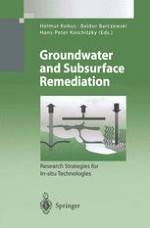1996 | OriginalPaper | Buchkapitel
Coupling Chemical Reactors with Particle Tracking Transport Models
verfasst von : Jean Pierre Sauty
Erschienen in: Groundwater and Subsurface Remediation
Verlag: Springer Berlin Heidelberg
Enthalten in: Professional Book Archive
Aktivieren Sie unsere intelligente Suche, um passende Fachinhalte oder Patente zu finden.
Wählen Sie Textabschnitte aus um mit Künstlicher Intelligenz passenden Patente zu finden. powered by
Markieren Sie Textabschnitte, um KI-gestützt weitere passende Inhalte zu finden. powered by
Designing in-situ subsurface remediation projects involves predictive modelling of pollutant migration and interactions, coupling a moving fluid transport simulator with chemical models. This type of tool has a wide variety of applications: interpretation of in situ and laboratory experiments, risk assessment of hazardous facilities such as wastes disposal sites, prediction of the fate of pollutants, etc. The approach developed at BRGM (French Geological Survey) is based on sequential coupling where different transport models and chemical simulators are alternately associated. The domain investigated is divided into a number of cells which are considered to be individual chemical reactors, closed for the duration of the time step. Once the chemistry reaction has been calculated (either assumed to be at equilibrium or including kinetics) at time t + Δt, the aqueous solution moves downgradient to the next cells. Chemical models are obtained using a code generator that can transform interaction laws written in a quasi mathematical language into FORTRAN subroutines, and transport is simulated by particle tracking techniques, either random walk or the method of characteristics. Traditional transport simulation methods (finite element or difference) are also used and coupled.
